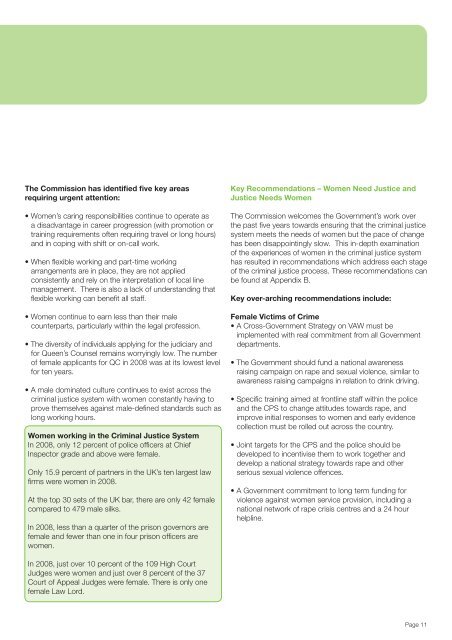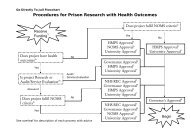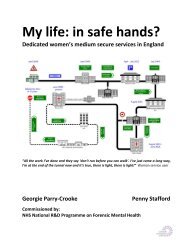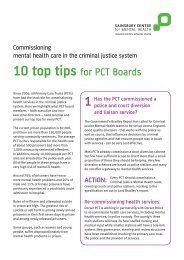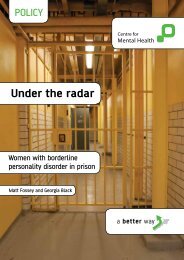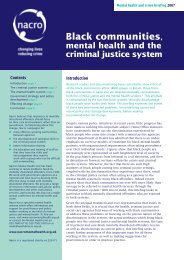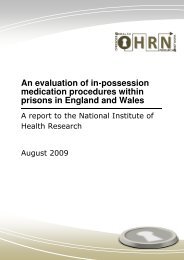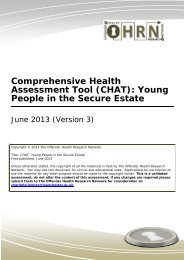Engendering Justice - from Policy to Practice - The Fawcett Society
Engendering Justice - from Policy to Practice - The Fawcett Society
Engendering Justice - from Policy to Practice - The Fawcett Society
- No tags were found...
You also want an ePaper? Increase the reach of your titles
YUMPU automatically turns print PDFs into web optimized ePapers that Google loves.
<strong>The</strong> Commission has identified five key areasrequiring urgent attention:• Women’s caring responsibilities continue <strong>to</strong> operate asa disadvantage in career progression (with promotion ortraining requirements often requiring travel or long hours)and in coping with shift or on-call work.• When flexible working and part-time workingarrangements are in place, they are not appliedconsistently and rely on the interpretation of local linemanagement. <strong>The</strong>re is also a lack of understanding thatflexible working can benefit all staff.• Women continue <strong>to</strong> earn less than their malecounterparts, particularly within the legal profession.• <strong>The</strong> diversity of individuals applying for the judiciary andfor Queen’s Counsel remains worryingly low. <strong>The</strong> numberof female applicants for QC in 2008 was at its lowest levelfor ten years.• A male dominated culture continues <strong>to</strong> exist across thecriminal justice system with women constantly having <strong>to</strong>prove themselves against male-defined standards such aslong working hours.Women working in the Criminal <strong>Justice</strong> SystemIn 2008, only 12 percent of police officers at ChiefInspec<strong>to</strong>r grade and above were female.Only 15.9 percent of partners in the UK’s ten largest lawfirms were women in 2008.At the <strong>to</strong>p 30 sets of the UK bar, there are only 42 femalecompared <strong>to</strong> 479 male silks.In 2008, less than a quarter of the prison governors arefemale and fewer than one in four prison officers arewomen.Key Recommendations – Women Need <strong>Justice</strong> and<strong>Justice</strong> Needs Women<strong>The</strong> Commission welcomes the Government’s work overthe past five years <strong>to</strong>wards ensuring that the criminal justicesystem meets the needs of women but the pace of changehas been disappointingly slow. This in-depth examinationof the experiences of women in the criminal justice systemhas resulted in recommendations which address each stageof the criminal justice process. <strong>The</strong>se recommendations canbe found at Appendix B.Key over-arching recommendations include:Female Victims of Crime• A Cross-Government Strategy on VAW must beimplemented with real commitment <strong>from</strong> all Governmentdepartments.• <strong>The</strong> Government should fund a national awarenessraising campaign on rape and sexual violence, similar <strong>to</strong>awareness raising campaigns in relation <strong>to</strong> drink driving.• Specific training aimed at frontline staff within the policeand the CPS <strong>to</strong> change attitudes <strong>to</strong>wards rape, andimprove initial responses <strong>to</strong> women and early evidencecollection must be rolled out across the country.• Joint targets for the CPS and the police should bedeveloped <strong>to</strong> incentivise them <strong>to</strong> work <strong>to</strong>gether anddevelop a national strategy <strong>to</strong>wards rape and otherserious sexual violence offences.• A Government commitment <strong>to</strong> long term funding forviolence against women service provision, including anational network of rape crisis centres and a 24 hourhelpline.In 2008, just over 10 percent of the 109 High CourtJudges were women and just over 8 percent of the 37Court of Appeal Judges were female. <strong>The</strong>re is only onefemale Law Lord.Page 11


